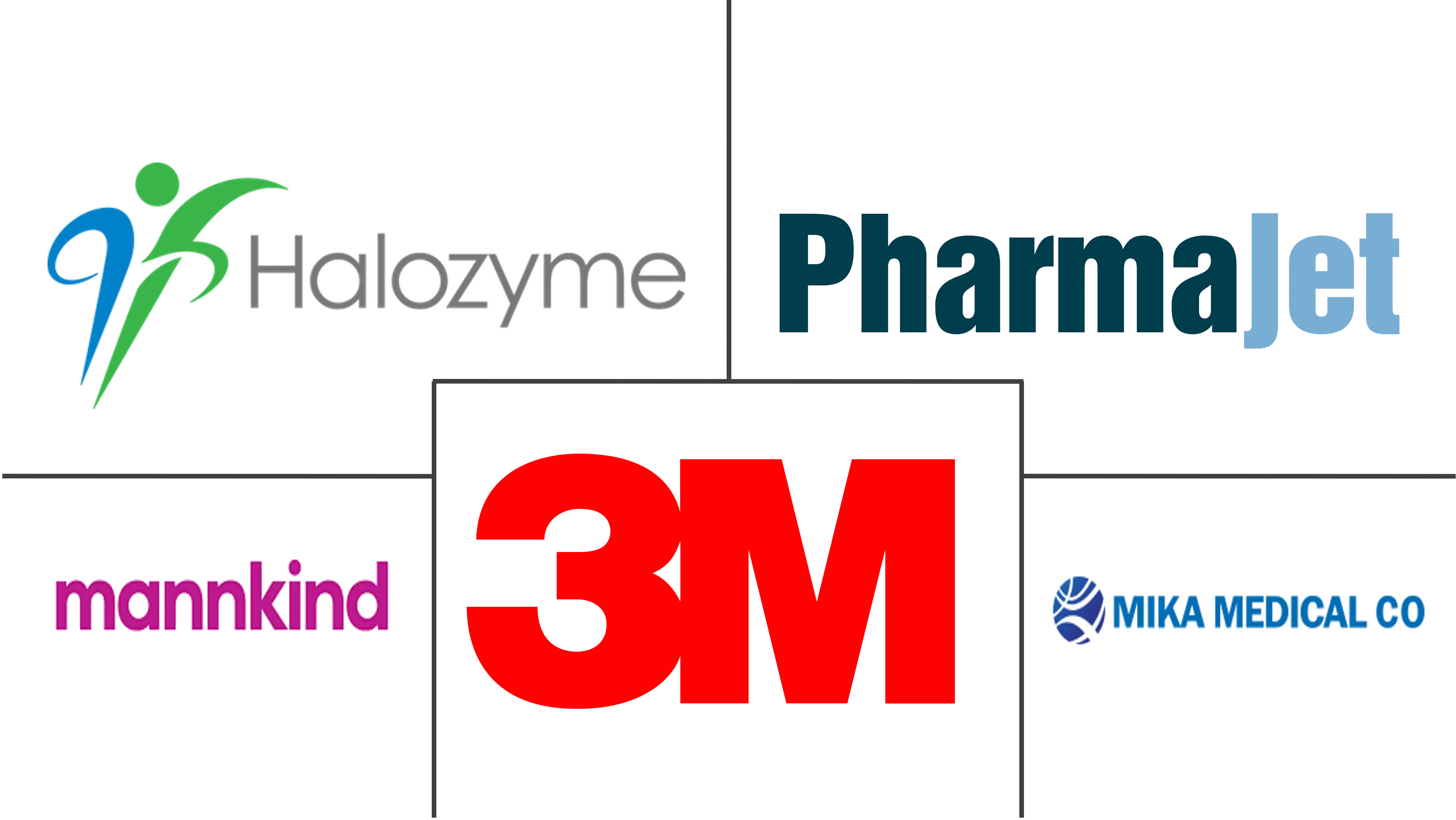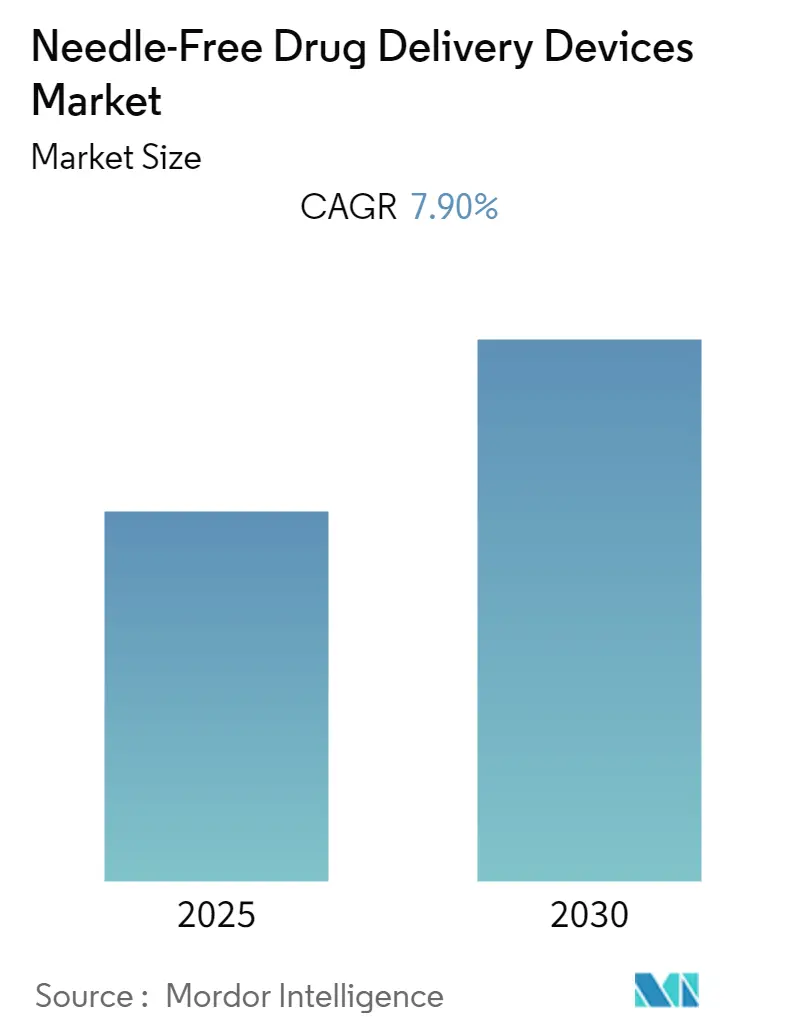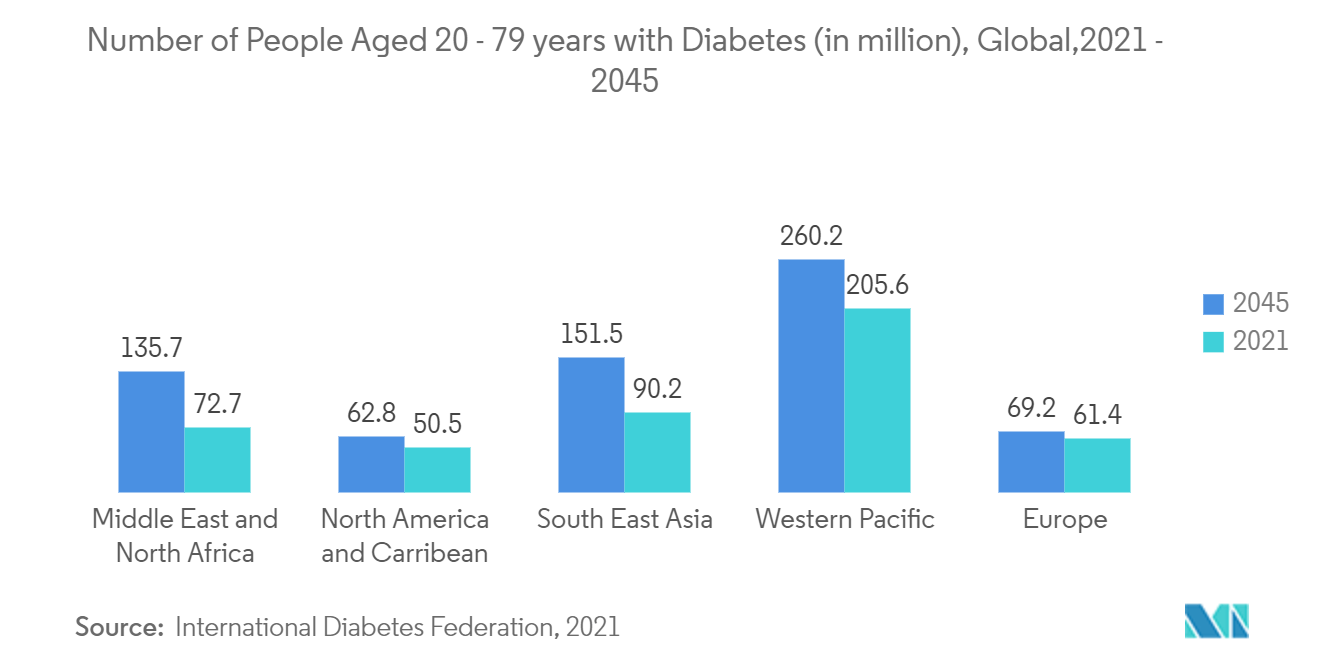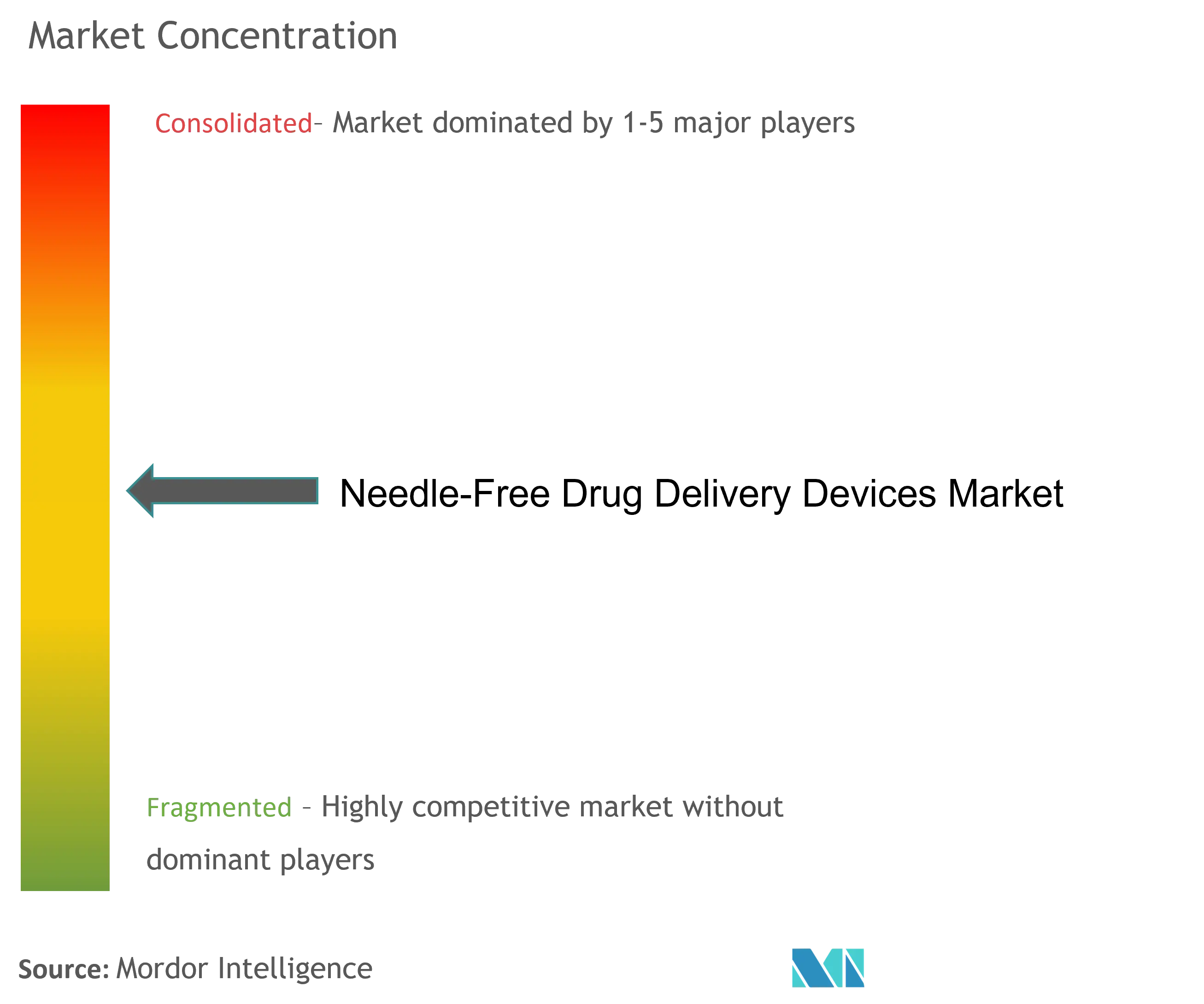Needle-Free Drug Delivery Devices Market Analysis
The Needle-Free Drug Delivery Devices Market is expected to register a CAGR of 7.9% during the forecast period.
- COVID-19 impacted the studied market, as the demand for needle-free devices increased during the pandemic for vaccination. However, the volume of these devices was not significant due to less adoption of needle-free devices over syringes. Some pharmaceutical companies and governments worked toward offering efficient medical treatment to COVID-19 patients, and needle-free drug delivery devices played a vital role in that context as these devices were used in administering drugs and vaccines.
- For instance, in December 2022, the government of India approved Bharat Biotech's intranasal vaccine for COVID-19. Also, various institutes performed research studies for the development of needle-free vaccine delivery systems. Therefore, the market reported a slight growth during the pandemic. Moreover, with the ongoing vaccinations, approval of needle-free vaccines, and the emergence of new covid strains, the demand for needle-free drug delivery devices is further expected to increase during the forecast period.
- The rising prevalence of chronic diseases requiring long hospital stays is expected to propel the market growth. As needle-free devices reduce the risk of safe needle disposal and avoid accidental needle stick injuries, propelling the market growth. For instance, according to the American Cancer Society Cancer Statistics 2023, 1.9 million new cancer cases are predicted to be diagnosed in the United States in 2023. The high burden of cancer creates an opportunity for market players the development of innovative needle-free drug delivery devices for cancer, which is expected to propel market growth.
- In addition, various research studies conducted for the development of technologically advanced needle-free drug delivery devices are also contributing to the market's growth. For instance, as per a research study published in Pharmaceutics Journal in November 2021, a compressed air-driven needle-free jet injection system with a hydro-pneumatic mechanism was designed and developed for controlled release and repeated biopharmaceutical delivery. Thus, the rising research activities to develop advanced needle-free drug delivery devices are expected to propel market growth.
- Furthermore, various companies are adopting strategic initiatives such as product innovation, launches, partnerships, and expansions for the development and expansion of needle-free drug delivery devices, propelling the market growth. For instance, in May 2022, Gerresheimer AG expanded its portfolio of technologies for drug delivery by investing in US-based Portal Instruments, a developer of a next-generation needle-free drug delivery technology. The partnership is aimed at improving the patient's experience, especially for those with chronic diseases, by transforming the administration of injectable biologics and biosimilars. Such expansions of the portfolio with innovative technologies and partnership among market players is expected to propel market growth.
- Therefore, owing to the aforementioned factors, such as the high burden of chronic diseases and rising research and development and product launches, the studied market is anticipated to witness growth over the analysis period. However, the stringent regulatory framework and limitations associated with using micro-needle patches are the few factors restraining the growth of the global needle-free drug delivery devices market.
Needle-Free Drug Delivery Devices Market Trends
Insulin Delivery Segment is Expected to Witness Good Growth in Application Segment Over the Forecast Period
- The insulin delivery segment is expected to witness significant growth over the forecast period owing to factors such as increasing cases of diabetes and increasing adoption of technologically advanced products.
- As per the International Diabetes Federation (IDF) 2021 report, the number of adults (20-79 years) with diabetes was 536.6 million in 2021, and it is predicted to reach 783.2 million by 2045. As per the same source, over 1.2 million children and adolescents under the age of 20 had type 1 diabetes in 2021.
- The demand for needle-free insulin delivery devices is expected to increase with the upsurge in the diabetic population and the advantages offered by these devices over other conventional insulin delivery systems such as pens, pumps, and needles. Hence, the high burden of type 1 diabetes is projected to bolster the demand for insulin delivery among the patient population, boosting the market segment's growth.
- According to an article published in Frontiers in Endocrinology Journal in April 2022, needle-free insulin therapy showed a better hypoglycemic effect as compared with traditional needle-injected insulin therapy. It significantly improved the satisfaction of patients with insulin therapy. Hence, based on various research studies, needle-free syringes are found to have better safety. The high number of research studies proving the efficacy and patient satisfaction is expected to create demand for needle-free insulin drug delivery systems and augment the segment growth during the forecast period.
- Furthermore, company developments with respect to needle-free drug delivery are expected to propel the growth of the segments. For instance, in June 2022, Transdermal Specialties Global completed a phase 3 clinical trial of a patented transdermal patch using the U-StripTM transdermal insulin delivery system. Thus, the increasing prevalence of diabetes and the technological advancements in needle-free insulin delivery devices are expected to drive the overall growth of the segment over the forecast period.
North America is Expected to Hold a Significant Market Share Over The Forecast Period
- North America is expected to hold a significant market share owing to the factors such as the high burden of chronic diseases and the increasing research and development by the major players for the development of innovative devices.
- As per International Diabetes Federation (IDF) 2021 report, the number of adults (20-79 years) with diabetes in the North American region (including the United States, Canada, and Mexico) was 49.3 million in 2021. As per the same source, the number of diabetes in the North American region is predicted to reach over 55 million by 2030. The rising burden of diabetes in the region is expected to propel the demand for needle-free insulin delivery devices, thereby augmenting the market growth.
- In addition, according to the Alzheimer's Association, Alzheimer's Disease Facts and Figures 2022, it is estimated that 6.5 million Americans aged 65 and over will be living with Alzheimer's dementia in 2022. Both Alzheimer's and diabetes treatments involve using multiple drug delivery devices for effective drug administration. Thus, the significant prevalence of the diseases will, in turn, spur the demand for needle-free devices among the patient population.
- Furthermore, the rising approvals for needle-free drug delivery devices are projected to expedite the growth of the regional market. For instance, in March 2022, Corium, Inc. received approval from the United States FDA for ADLARITY (donepezil transdermal system) as a treatment for patients with mild, moderate, or severe dementia of Alzheimer's type.
- Also, in June 2022, NovaXS Biotech, based in the United States, revealed the new prototype for its needle-free injection therapy smart medical device. Telosis, a patent-pending technology from the company, delivers a narrow stream of medication without a needle in 0.3 seconds and evaluates injection data to enable wiser medical choices. The company claimed that its technology offered a simple and painless substitute for at-home medicine delivery, serving as the first remote medication and self-administration monitoring platform. IVF procedures are considered the first indication of NovaXS.
- Thus, owing to the above-mentioned factors, such as the high prevalence of chronic diseases and rising product launches, the studied market in the North American region is expected to register significant growth over the forecast period.
Needle-Free Drug Delivery Devices Industry Overview
The needle-free drug delivery devices market is moderately competitive. The market is currently dominated by innovative companies that are coming up with novel products through the use of technology that reduces the use of needles for drug administration. Some of the companies that currently have a considerable share in the market are Halozyme, Inc. (Antares Pharma.), 3M, PharmaJet, Mika Medical Co., MannKind Corporation, PenJet, Crossject, Ferring B.V., and Akra Dermojet, among others.
Needle-Free Drug Delivery Devices Market Leaders
-
PharmaJet
-
3M
-
MannKind Corporation
-
Mika Medical Co.
-
Halozyme, Inc. (Antares Pharma)
- *Disclaimer: Major Players sorted in no particular order
Needle-Free Drug Delivery Devices Market News
- May 2022: Halozyme completed its acquisition of Antares Pharma Inc., establishing a drug delivery company with numerous potential for licensing its ENHANZE and Antares' auto-injector technology.
- May 2022: Zealand Pharma A/S entered into an asset purchase agreement with MannKind Corporation to sell the V-Go insulin delivery device for USD 10 million and additional sales-based milestones. V-Go is a once-daily, wearable, patch-like insulin delivery device that helps provide
Needle-Free Drug Delivery Devices Industry Segmentation
As per the scope of this report, needle-free drug delivery systems are novel ways to introduce various medicines to patients without piercing the skin with a needle. This method has drastically increased the adoption of important drugs through self-injections.
The needle-free drug delivery devices market is segmented by device type (inhalers, jet injectors, novel needles, transdermal patches, and other devices), application (insulin delivery, vaccination, pain management, and other applications), and geography (North America, Europe, Asia Pacific, Middle East and Africa, and South America). The report also covers the estimated market sizes and trends for 17 countries across major regions globally.
The report offers the value (in USD) for the above segments.
| By Device Type | Inhalers | ||
| Jet Injectors | |||
| Novel Needles | |||
| Transdermal Patches | |||
| Other Devices | |||
| By Application | Insulin Delivery | ||
| Vaccination | |||
| Pain Management | |||
| Other Applications | |||
| Geography | North America | United States | |
| Canada | |||
| Mexico | |||
| Europe | Germany | ||
| United Kingdom | |||
| France | |||
| Italy | |||
| Spain | |||
| Rest of Europe | |||
| Asia-Pacific | China | ||
| Japan | |||
| India | |||
| Australia | |||
| South Korea | |||
| Rest of Asia-Pacific | |||
| Middle East and Africa | GCC | ||
| South Africa | |||
| Rest of Middle East and Africa | |||
| South America | Brazil | ||
| Argentina | |||
| Rest of South America | |||
Needle Free Drug Delivery Devices Market Research FAQs
What is the current Needle-Free Drug Delivery Devices Market size?
The Needle-Free Drug Delivery Devices Market is projected to register a CAGR of 7.9% during the forecast period (2025-2030)
Who are the key players in Needle-Free Drug Delivery Devices Market?
PharmaJet, 3M, MannKind Corporation, Mika Medical Co. and Halozyme, Inc. (Antares Pharma) are the major companies operating in the Needle-Free Drug Delivery Devices Market.
Which is the fastest growing region in Needle-Free Drug Delivery Devices Market?
Asia Pacific is estimated to grow at the highest CAGR over the forecast period (2025-2030).
Which region has the biggest share in Needle-Free Drug Delivery Devices Market?
In 2025, the North America accounts for the largest market share in Needle-Free Drug Delivery Devices Market.
What years does this Needle-Free Drug Delivery Devices Market cover?
The report covers the Needle-Free Drug Delivery Devices Market historical market size for years: 2019, 2020, 2021, 2022, 2023 and 2024. The report also forecasts the Needle-Free Drug Delivery Devices Market size for years: 2025, 2026, 2027, 2028, 2029 and 2030.
Our Best Selling Reports
Needle-Free Drug Delivery Devices Industry Report
Statistics for the 2025 Needle-Free Drug Delivery Devices market share, size and revenue growth rate, created by Mordor Intelligence™ Industry Reports. Needle-Free Drug Delivery Devices analysis includes a market forecast outlook for 2025 to 2030 and historical overview. Get a sample of this industry analysis as a free report PDF download.







